Remember times when WordPress was a blogging engine only? The reason why it wasn’t suitable for other website types was simple. Back then, not even a single WordPress custom post type plugin existed to help users build their own custom sections.
Today, custom post types provide complete control over the content. Let’s take a closer look at such an important WP element and see how it works…
What is WordPress Custom Post Type?
WordPress holds a variety of content types and taxonomies defined by default, namely:
- Posts
- Pages
- Attachments
- Navigation Menus
- Revisions
Due to a huge variety of websites, today’s users can’t limit themselves to just 5 content types. That’s when custom post types enter the game and all the fun begins.
The WP custom post type is a piece of content allowing you to define any content type without being limited to just the predefined WordPress post types. The content types can be anything: from Portfolio Surveys and Movie & Book Reviews to the Products page for an online store.
Since the introduction of highly advanced tools, the earlier-considered “blogging platform” turned into a full-fledged content management system able to support any type of site, regardless of its content.
Want to write posts with AI in the WordPress block editor? Get a free AI block.
How to Add Custom Post Type to Your Website?
There exist 2 ways to create a custom post type and its taxonomies:
- Manually (making changes in code).
- Through plugin installation.
Today, I will be helpful to all WP users who want to implement custom post types as blocks in the Gutenberg editor.
To accomplish this task, we need at least one WordPress custom post type plugin out of the next four:
Top 4 Plugins To Build Custom Post Types In Gutenberg

One of the best solutions for creating custom post types as Gutenberg blocks is Getwid. The free plugin originally consists of 40+ multipurpose Gutenberg blocks, and each of them features extensive configuration settings.
The main purpose of the Custom Post Type WordPress block by Getwid is to display content sourced from different post types in a list or grid. It shows posts in a responsive and creative manner with multiple sorting and filtering options.
- To start working with the Getwid-based WordPress custom posts, make sure you installed and activated Getwid in your WP dashboard.
- As soon as you start customizing pages in the block editor, you will see a list of Getwid WordPress blocks among other available Gutenberg blocks & templates.
- When adding a new block on your website, search for Custom Post Type, then insert the element:
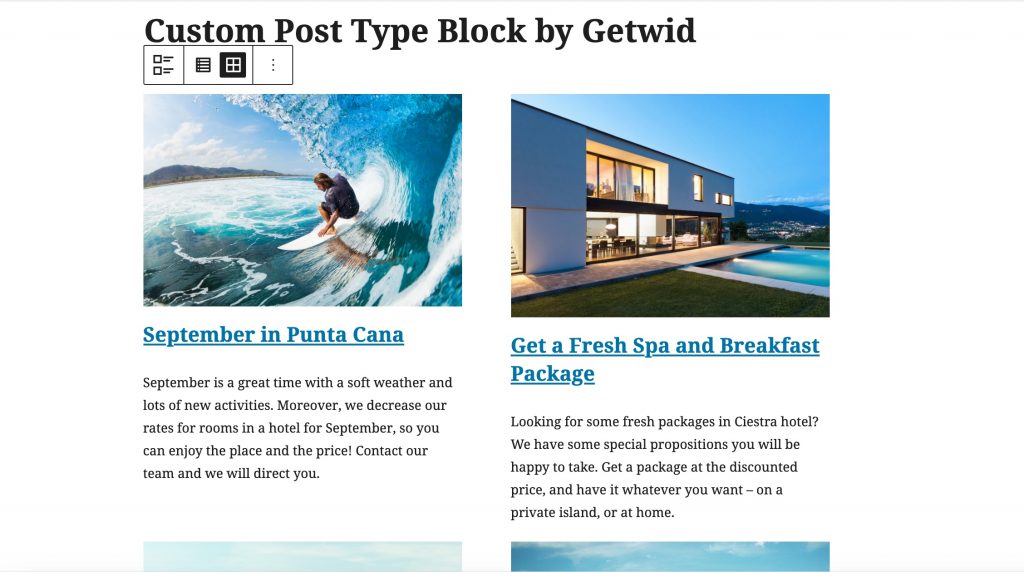
- The given WordPress Gutenberg blocks give you a choice to display different content types: from default Posts and Pages to custom ones. Custom post types are usually generated from the installed themes & plugins (mine are Accommodation Types and Services):
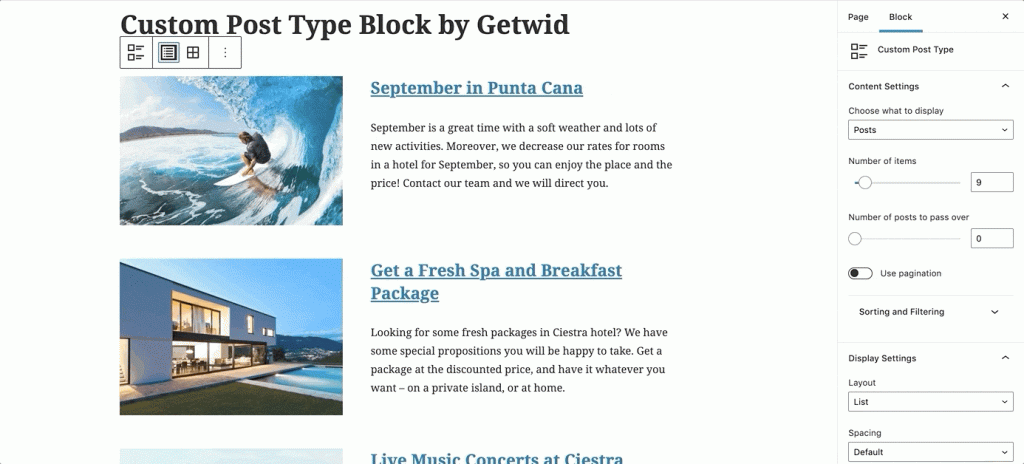
- In the Content settings, you may also configure 1) the number of shown items, 2) the number of posts to pass over, and 3) pagination (in case you want to stock content in pages).
- In the Sorting & Filtering submenu, you may order content by different criteria. There is an option to display specific posts of your choice or display ALL posts with a few ones excluded. Also, you may specify the taxonomies, Terms, and Term Relations:
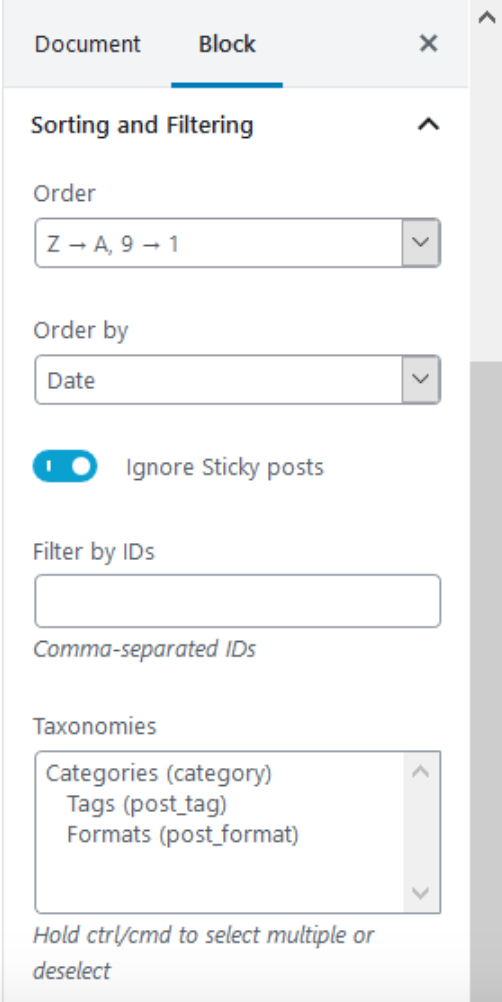
- Change the Posts display to Grid or List in the top left bar or in the Settings display:
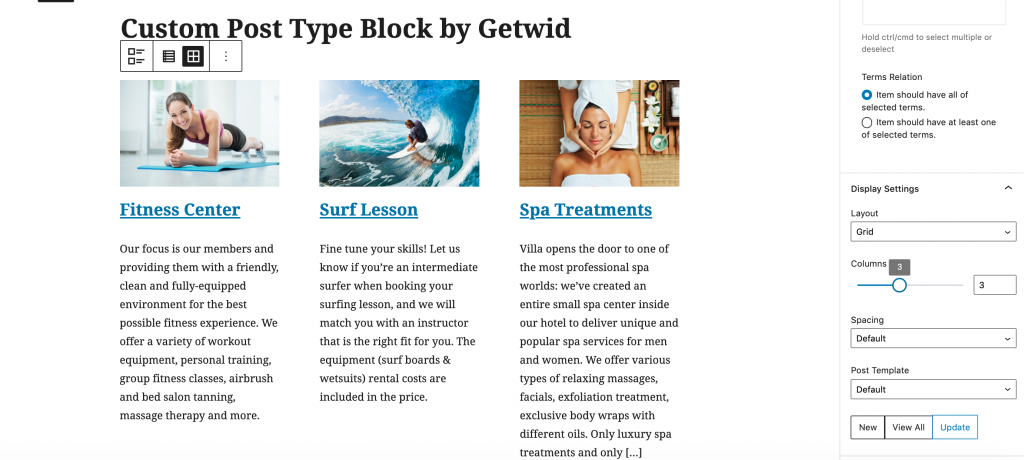
In the same submenu, you can alter the number of columns and spacing. More importantly, you will be able to change the post template from default to a custom one. Click NEW, create & edit the layout to your liking, update the page, and choose the given template from the drop-down list.
E.g. I chose the template with the background featured image:
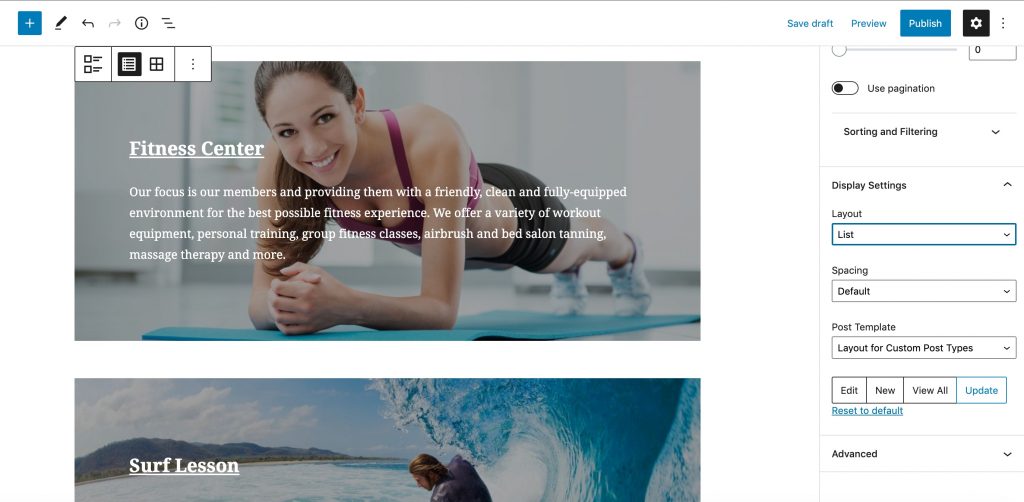
The full video tutorial on the Custom Post Block is available here:
PostX – Gutenberg Post Grid Blocks

The PostX Gutenberg plugin provides one of the most diverse blog post blocks. The variety of post layouts allow you to experiment with designs and stand out with the most unusual post templates. Use the Advanced Query form to easily customize queries from the block settings panel.
Key features:
- Advanced Query Builder
- Beautiful Post Grid Blocks
- Dynamic Slider (Supports any Post type)
- Starter Packs
- Ready-made block designs

Custom Query Blocks offers 3 types of blocks: 1) Term (category) Grid block, 2) Featured Posts By Category block, and most importantly for us, 3) Custom Post Types block.
The Custom Query Blocks plugin enables you to create custom post blocks with an unlimited number of posts, pagination, and no AMP error messages.
Key features:
- 3 types of blocks
- Archive mapping
- Wide-width mode
- AMP-read

You may have heard of Stackable as one of the well-known providers of Gutenberg blocks and designs. The collection includes a powerful Blog Posts block with the ability to configure your own post type block in the default WP editor.
Unlike the Getwid Custom Post Type block, this one features the ability to get custom post type in a premium version only.
Key features:
- Feature specific post articles
- Display dynamically loaded blog posts
- Advanced Blog Post options (premium)
More Popular WordPress Plugins With Custom Post Types
Did you know some of the top-rated plugins built for different website types & purposes contain WordPress custom post types?
- WooCommerce – provides complete eCommerce functionality. The WooCommerce custom post type is the Products page;
- WPForms – an ultimate builder of all common website forms (Contact, Payment, Newsletter, Survey, Registration, etc);
- MemberPress – an ultimate tool for creating, managing, and tracking membership subscriptions.
Conclusion:
That’s it! We’ve covered 4 custom post types WordPress plugins that support Gutenberg blocks integration.
Obviously, the world’s most popular CMS offers a lot more custom post type plugins that will support customization in Gutenberg.
Those are:
- Custom Post Type UI
- Pods – Custom Content Types and Fields
- Custom Post Types and Custom Fields creator – WCK
- …and more.
Assuming that most of this software comes free of charge, you have a chance to test all solutions and decide on which one suits you most.
Do not forget to share which WordPress custom post type plugin you chose and why 🙂
